Needs Assessment for Cardiovascular Disease Among Australian Indigenous INTRODUCTION 3 MAIN BODY3 Assessment of needs 3 Methods of needs assessment 4 Literature Reviews 4 Potential challenges for need
VerifiedAdded on 2021/02/21
|8
|2068
|275
AI Summary
Cardiovascular Disease Among Australian Indigenous INTRODUCTION 3 MAIN BODY3 Assessment of needs 3 Methods of Needs Assessment 4 Literature Reviews 4 Potential challenges for needs assessment 6 SWOT Analysis 6 Determination of priorities 7 CONCLUSION 7 REFERENCES 8 INTRODUCTION Cardiovascular disease refers to a medical condition of an individual that consist narrowed or blocked blood vessels which may leads to a heart attack, chest pain (angina) and stroke. It basically consist entire such conditions which are responsible for affectingthestructuresand functioning of heart including
Contribute Materials
Your contribution can guide someone’s learning journey. Share your
documents today.
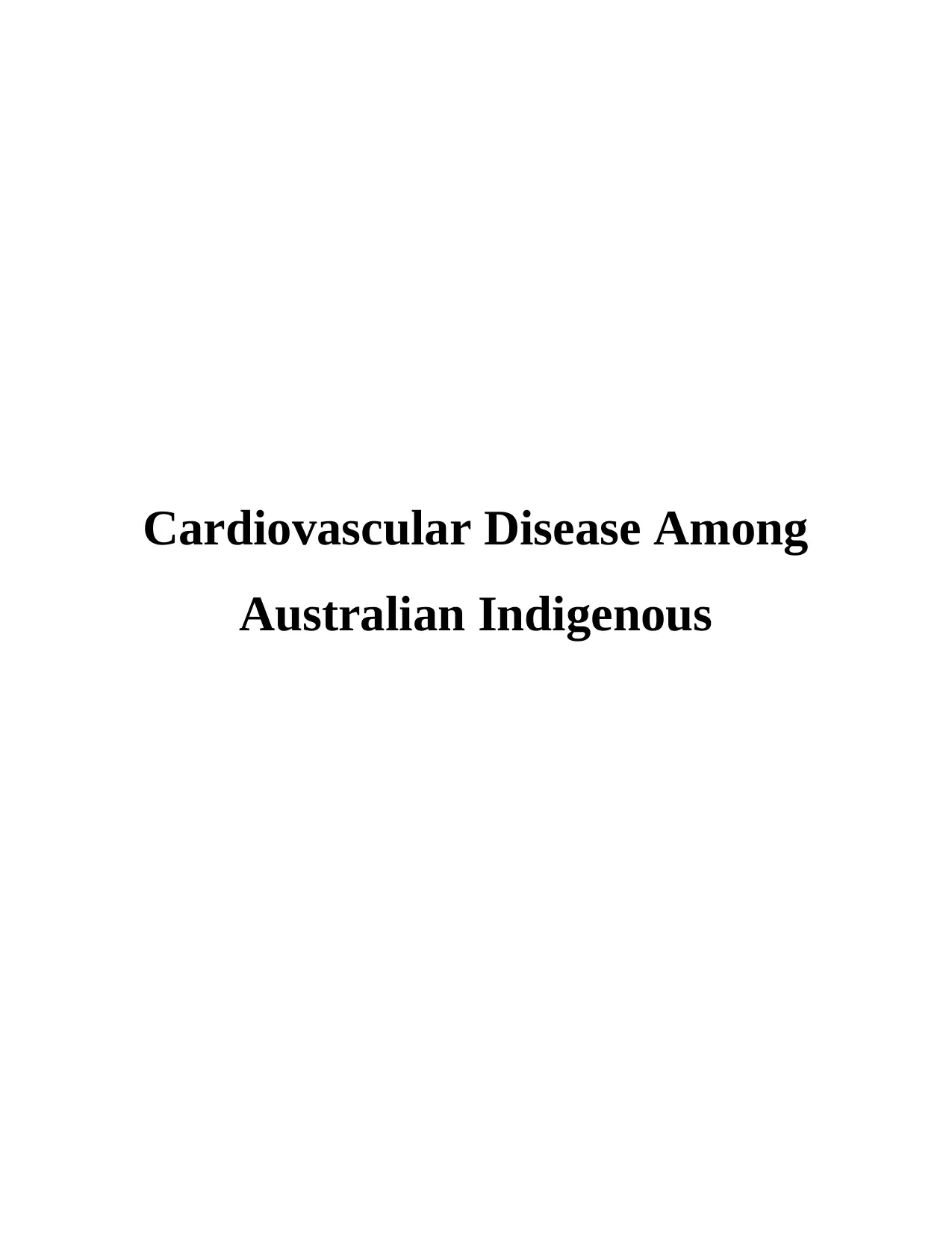
Cardiovascular Disease Among
Australian Indigenous
Australian Indigenous
Secure Best Marks with AI Grader
Need help grading? Try our AI Grader for instant feedback on your assignments.
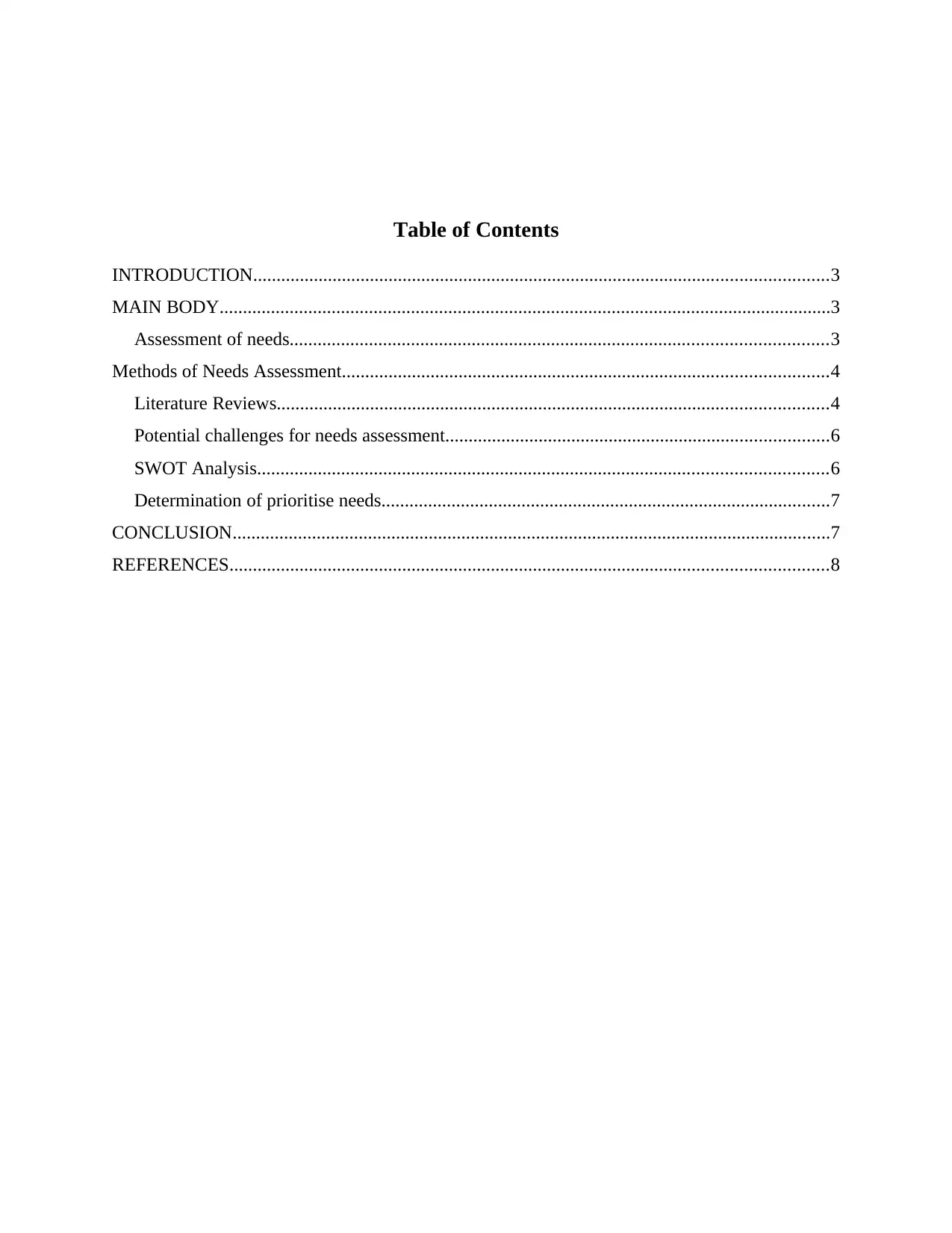
Table of Contents
INTRODUCTION...........................................................................................................................3
MAIN BODY...................................................................................................................................3
Assessment of needs...................................................................................................................3
Methods of Needs Assessment........................................................................................................4
Literature Reviews......................................................................................................................4
Potential challenges for needs assessment..................................................................................6
SWOT Analysis..........................................................................................................................6
Determination of prioritise needs................................................................................................7
CONCLUSION................................................................................................................................7
REFERENCES................................................................................................................................8
INTRODUCTION...........................................................................................................................3
MAIN BODY...................................................................................................................................3
Assessment of needs...................................................................................................................3
Methods of Needs Assessment........................................................................................................4
Literature Reviews......................................................................................................................4
Potential challenges for needs assessment..................................................................................6
SWOT Analysis..........................................................................................................................6
Determination of prioritise needs................................................................................................7
CONCLUSION................................................................................................................................7
REFERENCES................................................................................................................................8
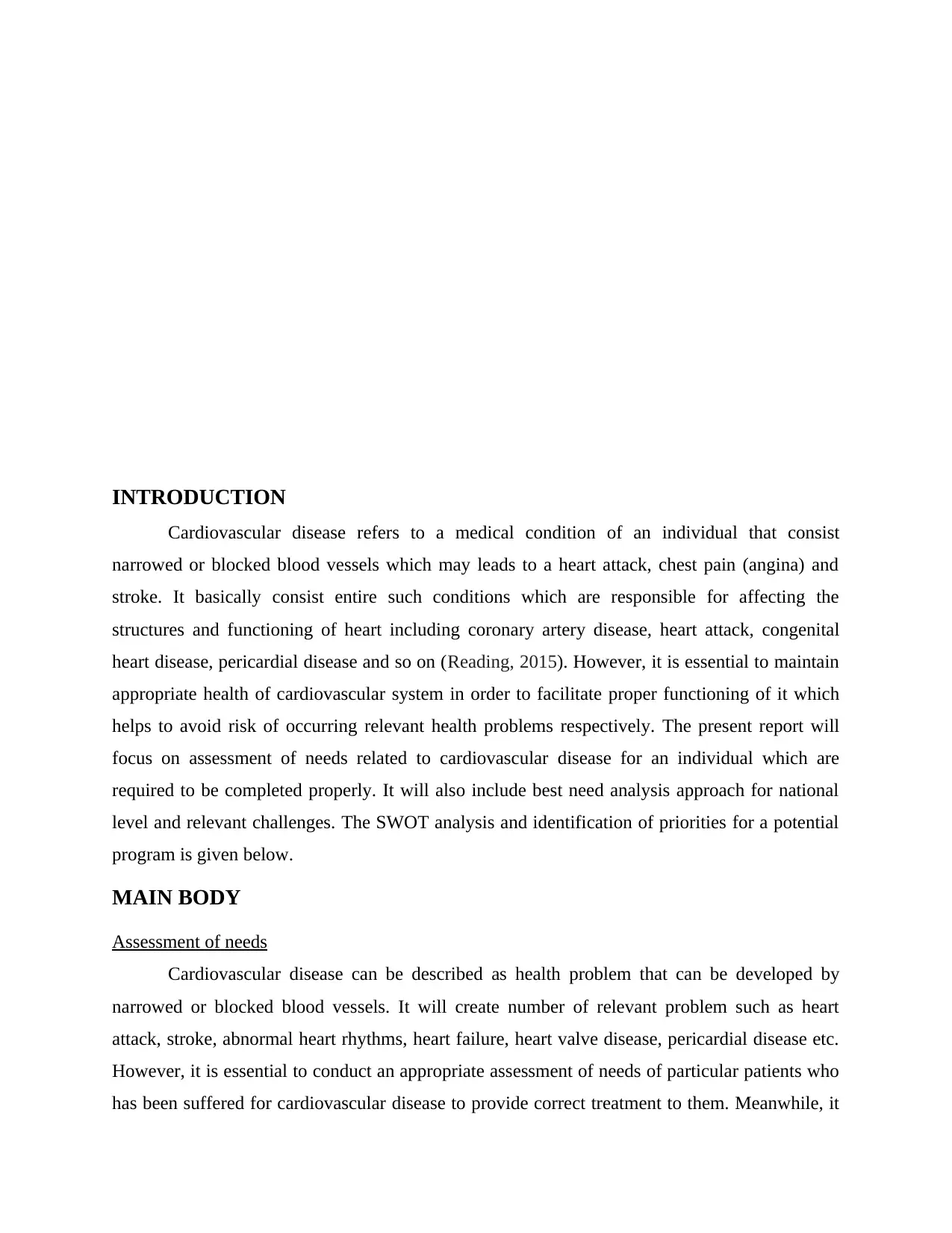
INTRODUCTION
Cardiovascular disease refers to a medical condition of an individual that consist
narrowed or blocked blood vessels which may leads to a heart attack, chest pain (angina) and
stroke. It basically consist entire such conditions which are responsible for affecting the
structures and functioning of heart including coronary artery disease, heart attack, congenital
heart disease, pericardial disease and so on (Reading, 2015). However, it is essential to maintain
appropriate health of cardiovascular system in order to facilitate proper functioning of it which
helps to avoid risk of occurring relevant health problems respectively. The present report will
focus on assessment of needs related to cardiovascular disease for an individual which are
required to be completed properly. It will also include best need analysis approach for national
level and relevant challenges. The SWOT analysis and identification of priorities for a potential
program is given below.
MAIN BODY
Assessment of needs
Cardiovascular disease can be described as health problem that can be developed by
narrowed or blocked blood vessels. It will create number of relevant problem such as heart
attack, stroke, abnormal heart rhythms, heart failure, heart valve disease, pericardial disease etc.
However, it is essential to conduct an appropriate assessment of needs of particular patients who
has been suffered for cardiovascular disease to provide correct treatment to them. Meanwhile, it
Cardiovascular disease refers to a medical condition of an individual that consist
narrowed or blocked blood vessels which may leads to a heart attack, chest pain (angina) and
stroke. It basically consist entire such conditions which are responsible for affecting the
structures and functioning of heart including coronary artery disease, heart attack, congenital
heart disease, pericardial disease and so on (Reading, 2015). However, it is essential to maintain
appropriate health of cardiovascular system in order to facilitate proper functioning of it which
helps to avoid risk of occurring relevant health problems respectively. The present report will
focus on assessment of needs related to cardiovascular disease for an individual which are
required to be completed properly. It will also include best need analysis approach for national
level and relevant challenges. The SWOT analysis and identification of priorities for a potential
program is given below.
MAIN BODY
Assessment of needs
Cardiovascular disease can be described as health problem that can be developed by
narrowed or blocked blood vessels. It will create number of relevant problem such as heart
attack, stroke, abnormal heart rhythms, heart failure, heart valve disease, pericardial disease etc.
However, it is essential to conduct an appropriate assessment of needs of particular patients who
has been suffered for cardiovascular disease to provide correct treatment to them. Meanwhile, it
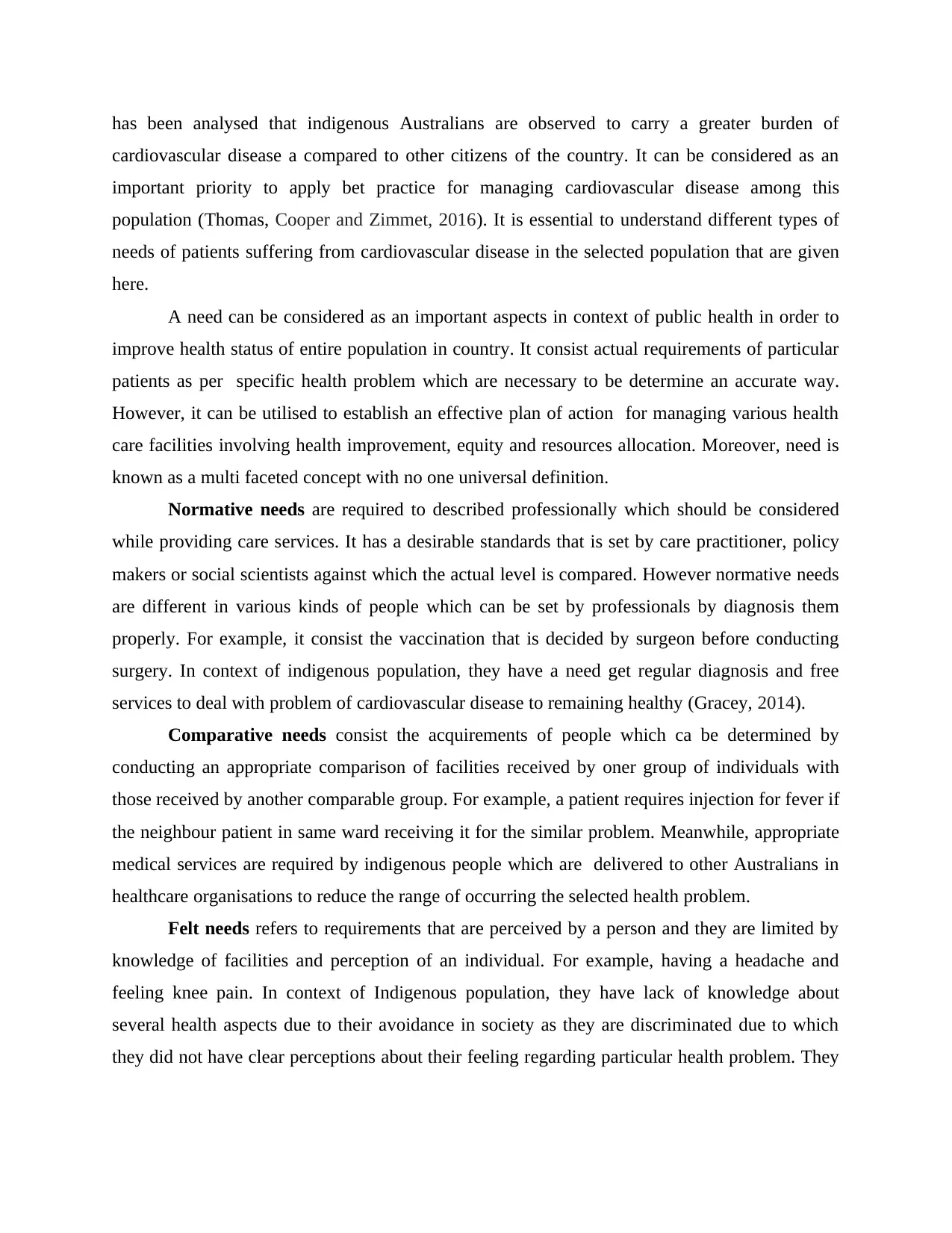
has been analysed that indigenous Australians are observed to carry a greater burden of
cardiovascular disease a compared to other citizens of the country. It can be considered as an
important priority to apply bet practice for managing cardiovascular disease among this
population (Thomas, Cooper and Zimmet, 2016). It is essential to understand different types of
needs of patients suffering from cardiovascular disease in the selected population that are given
here.
A need can be considered as an important aspects in context of public health in order to
improve health status of entire population in country. It consist actual requirements of particular
patients as per specific health problem which are necessary to be determine an accurate way.
However, it can be utilised to establish an effective plan of action for managing various health
care facilities involving health improvement, equity and resources allocation. Moreover, need is
known as a multi faceted concept with no one universal definition.
Normative needs are required to described professionally which should be considered
while providing care services. It has a desirable standards that is set by care practitioner, policy
makers or social scientists against which the actual level is compared. However normative needs
are different in various kinds of people which can be set by professionals by diagnosis them
properly. For example, it consist the vaccination that is decided by surgeon before conducting
surgery. In context of indigenous population, they have a need get regular diagnosis and free
services to deal with problem of cardiovascular disease to remaining healthy (Gracey, 2014).
Comparative needs consist the acquirements of people which ca be determined by
conducting an appropriate comparison of facilities received by oner group of individuals with
those received by another comparable group. For example, a patient requires injection for fever if
the neighbour patient in same ward receiving it for the similar problem. Meanwhile, appropriate
medical services are required by indigenous people which are delivered to other Australians in
healthcare organisations to reduce the range of occurring the selected health problem.
Felt needs refers to requirements that are perceived by a person and they are limited by
knowledge of facilities and perception of an individual. For example, having a headache and
feeling knee pain. In context of Indigenous population, they have lack of knowledge about
several health aspects due to their avoidance in society as they are discriminated due to which
they did not have clear perceptions about their feeling regarding particular health problem. They
cardiovascular disease a compared to other citizens of the country. It can be considered as an
important priority to apply bet practice for managing cardiovascular disease among this
population (Thomas, Cooper and Zimmet, 2016). It is essential to understand different types of
needs of patients suffering from cardiovascular disease in the selected population that are given
here.
A need can be considered as an important aspects in context of public health in order to
improve health status of entire population in country. It consist actual requirements of particular
patients as per specific health problem which are necessary to be determine an accurate way.
However, it can be utilised to establish an effective plan of action for managing various health
care facilities involving health improvement, equity and resources allocation. Moreover, need is
known as a multi faceted concept with no one universal definition.
Normative needs are required to described professionally which should be considered
while providing care services. It has a desirable standards that is set by care practitioner, policy
makers or social scientists against which the actual level is compared. However normative needs
are different in various kinds of people which can be set by professionals by diagnosis them
properly. For example, it consist the vaccination that is decided by surgeon before conducting
surgery. In context of indigenous population, they have a need get regular diagnosis and free
services to deal with problem of cardiovascular disease to remaining healthy (Gracey, 2014).
Comparative needs consist the acquirements of people which ca be determined by
conducting an appropriate comparison of facilities received by oner group of individuals with
those received by another comparable group. For example, a patient requires injection for fever if
the neighbour patient in same ward receiving it for the similar problem. Meanwhile, appropriate
medical services are required by indigenous people which are delivered to other Australians in
healthcare organisations to reduce the range of occurring the selected health problem.
Felt needs refers to requirements that are perceived by a person and they are limited by
knowledge of facilities and perception of an individual. For example, having a headache and
feeling knee pain. In context of Indigenous population, they have lack of knowledge about
several health aspects due to their avoidance in society as they are discriminated due to which
they did not have clear perceptions about their feeling regarding particular health problem. They
Secure Best Marks with AI Grader
Need help grading? Try our AI Grader for instant feedback on your assignments.
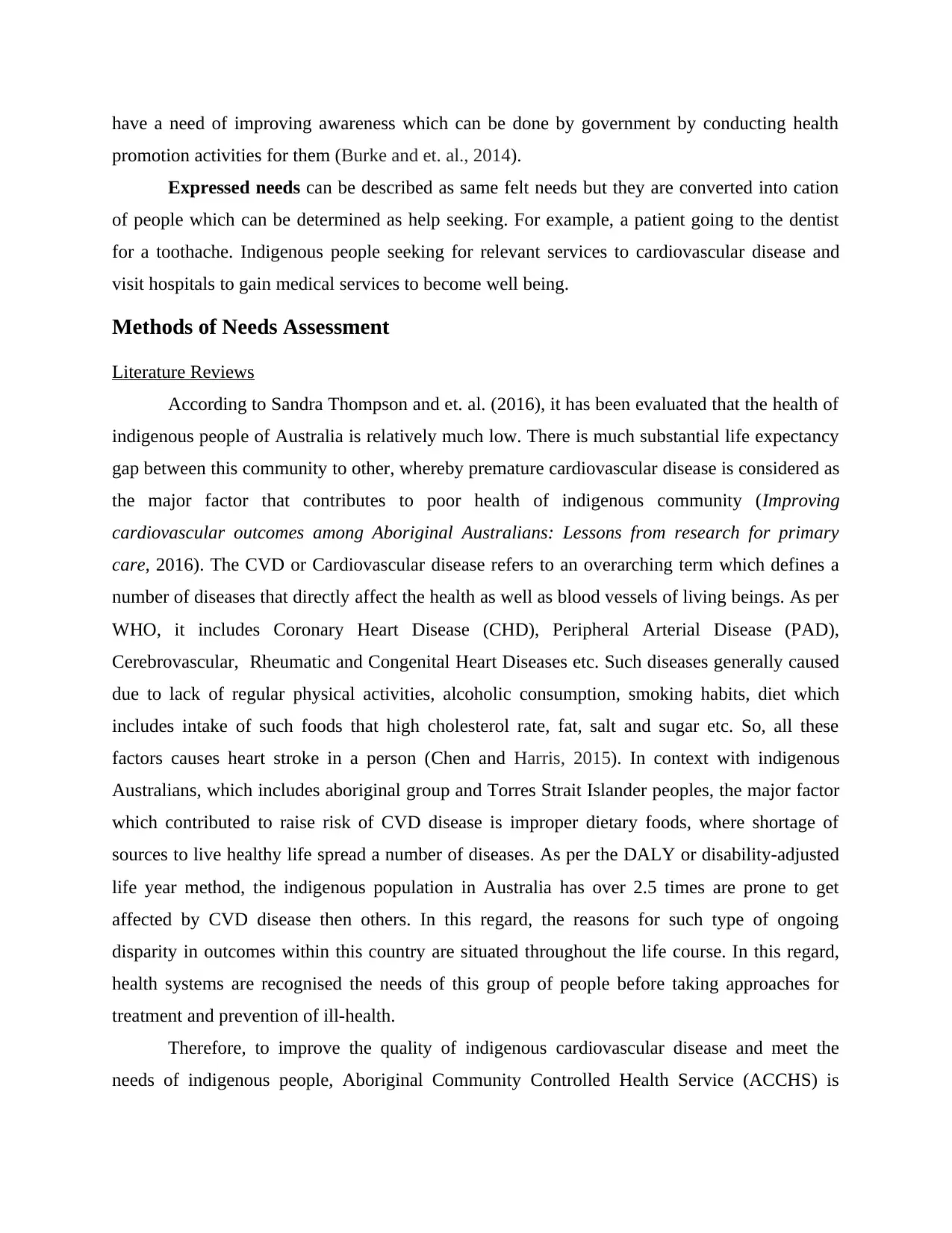
have a need of improving awareness which can be done by government by conducting health
promotion activities for them (Burke and et. al., 2014).
Expressed needs can be described as same felt needs but they are converted into cation
of people which can be determined as help seeking. For example, a patient going to the dentist
for a toothache. Indigenous people seeking for relevant services to cardiovascular disease and
visit hospitals to gain medical services to become well being.
Methods of Needs Assessment
Literature Reviews
According to Sandra Thompson and et. al. (2016), it has been evaluated that the health of
indigenous people of Australia is relatively much low. There is much substantial life expectancy
gap between this community to other, whereby premature cardiovascular disease is considered as
the major factor that contributes to poor health of indigenous community (Improving
cardiovascular outcomes among Aboriginal Australians: Lessons from research for primary
care, 2016). The CVD or Cardiovascular disease refers to an overarching term which defines a
number of diseases that directly affect the health as well as blood vessels of living beings. As per
WHO, it includes Coronary Heart Disease (CHD), Peripheral Arterial Disease (PAD),
Cerebrovascular, Rheumatic and Congenital Heart Diseases etc. Such diseases generally caused
due to lack of regular physical activities, alcoholic consumption, smoking habits, diet which
includes intake of such foods that high cholesterol rate, fat, salt and sugar etc. So, all these
factors causes heart stroke in a person (Chen and Harris, 2015). In context with indigenous
Australians, which includes aboriginal group and Torres Strait Islander peoples, the major factor
which contributed to raise risk of CVD disease is improper dietary foods, where shortage of
sources to live healthy life spread a number of diseases. As per the DALY or disability-adjusted
life year method, the indigenous population in Australia has over 2.5 times are prone to get
affected by CVD disease then others. In this regard, the reasons for such type of ongoing
disparity in outcomes within this country are situated throughout the life course. In this regard,
health systems are recognised the needs of this group of people before taking approaches for
treatment and prevention of ill-health.
Therefore, to improve the quality of indigenous cardiovascular disease and meet the
needs of indigenous people, Aboriginal Community Controlled Health Service (ACCHS) is
promotion activities for them (Burke and et. al., 2014).
Expressed needs can be described as same felt needs but they are converted into cation
of people which can be determined as help seeking. For example, a patient going to the dentist
for a toothache. Indigenous people seeking for relevant services to cardiovascular disease and
visit hospitals to gain medical services to become well being.
Methods of Needs Assessment
Literature Reviews
According to Sandra Thompson and et. al. (2016), it has been evaluated that the health of
indigenous people of Australia is relatively much low. There is much substantial life expectancy
gap between this community to other, whereby premature cardiovascular disease is considered as
the major factor that contributes to poor health of indigenous community (Improving
cardiovascular outcomes among Aboriginal Australians: Lessons from research for primary
care, 2016). The CVD or Cardiovascular disease refers to an overarching term which defines a
number of diseases that directly affect the health as well as blood vessels of living beings. As per
WHO, it includes Coronary Heart Disease (CHD), Peripheral Arterial Disease (PAD),
Cerebrovascular, Rheumatic and Congenital Heart Diseases etc. Such diseases generally caused
due to lack of regular physical activities, alcoholic consumption, smoking habits, diet which
includes intake of such foods that high cholesterol rate, fat, salt and sugar etc. So, all these
factors causes heart stroke in a person (Chen and Harris, 2015). In context with indigenous
Australians, which includes aboriginal group and Torres Strait Islander peoples, the major factor
which contributed to raise risk of CVD disease is improper dietary foods, where shortage of
sources to live healthy life spread a number of diseases. As per the DALY or disability-adjusted
life year method, the indigenous population in Australia has over 2.5 times are prone to get
affected by CVD disease then others. In this regard, the reasons for such type of ongoing
disparity in outcomes within this country are situated throughout the life course. In this regard,
health systems are recognised the needs of this group of people before taking approaches for
treatment and prevention of ill-health.
Therefore, to improve the quality of indigenous cardiovascular disease and meet the
needs of indigenous people, Aboriginal Community Controlled Health Service (ACCHS) is
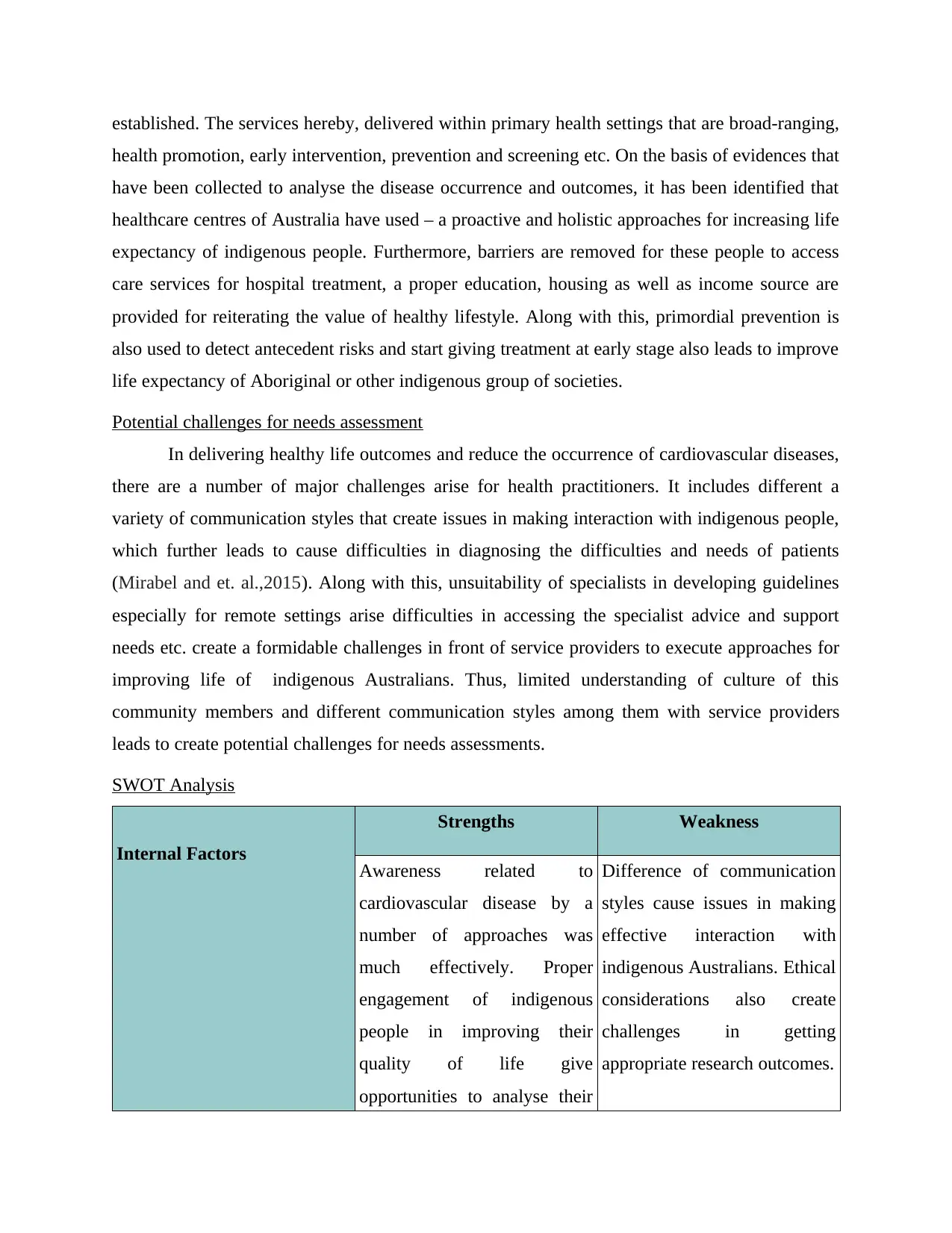
established. The services hereby, delivered within primary health settings that are broad-ranging,
health promotion, early intervention, prevention and screening etc. On the basis of evidences that
have been collected to analyse the disease occurrence and outcomes, it has been identified that
healthcare centres of Australia have used – a proactive and holistic approaches for increasing life
expectancy of indigenous people. Furthermore, barriers are removed for these people to access
care services for hospital treatment, a proper education, housing as well as income source are
provided for reiterating the value of healthy lifestyle. Along with this, primordial prevention is
also used to detect antecedent risks and start giving treatment at early stage also leads to improve
life expectancy of Aboriginal or other indigenous group of societies.
Potential challenges for needs assessment
In delivering healthy life outcomes and reduce the occurrence of cardiovascular diseases,
there are a number of major challenges arise for health practitioners. It includes different a
variety of communication styles that create issues in making interaction with indigenous people,
which further leads to cause difficulties in diagnosing the difficulties and needs of patients
(Mirabel and et. al.,2015). Along with this, unsuitability of specialists in developing guidelines
especially for remote settings arise difficulties in accessing the specialist advice and support
needs etc. create a formidable challenges in front of service providers to execute approaches for
improving life of indigenous Australians. Thus, limited understanding of culture of this
community members and different communication styles among them with service providers
leads to create potential challenges for needs assessments.
SWOT Analysis
Internal Factors
Strengths Weakness
Awareness related to
cardiovascular disease by a
number of approaches was
much effectively. Proper
engagement of indigenous
people in improving their
quality of life give
opportunities to analyse their
Difference of communication
styles cause issues in making
effective interaction with
indigenous Australians. Ethical
considerations also create
challenges in getting
appropriate research outcomes.
health promotion, early intervention, prevention and screening etc. On the basis of evidences that
have been collected to analyse the disease occurrence and outcomes, it has been identified that
healthcare centres of Australia have used – a proactive and holistic approaches for increasing life
expectancy of indigenous people. Furthermore, barriers are removed for these people to access
care services for hospital treatment, a proper education, housing as well as income source are
provided for reiterating the value of healthy lifestyle. Along with this, primordial prevention is
also used to detect antecedent risks and start giving treatment at early stage also leads to improve
life expectancy of Aboriginal or other indigenous group of societies.
Potential challenges for needs assessment
In delivering healthy life outcomes and reduce the occurrence of cardiovascular diseases,
there are a number of major challenges arise for health practitioners. It includes different a
variety of communication styles that create issues in making interaction with indigenous people,
which further leads to cause difficulties in diagnosing the difficulties and needs of patients
(Mirabel and et. al.,2015). Along with this, unsuitability of specialists in developing guidelines
especially for remote settings arise difficulties in accessing the specialist advice and support
needs etc. create a formidable challenges in front of service providers to execute approaches for
improving life of indigenous Australians. Thus, limited understanding of culture of this
community members and different communication styles among them with service providers
leads to create potential challenges for needs assessments.
SWOT Analysis
Internal Factors
Strengths Weakness
Awareness related to
cardiovascular disease by a
number of approaches was
much effectively. Proper
engagement of indigenous
people in improving their
quality of life give
opportunities to analyse their
Difference of communication
styles cause issues in making
effective interaction with
indigenous Australians. Ethical
considerations also create
challenges in getting
appropriate research outcomes.
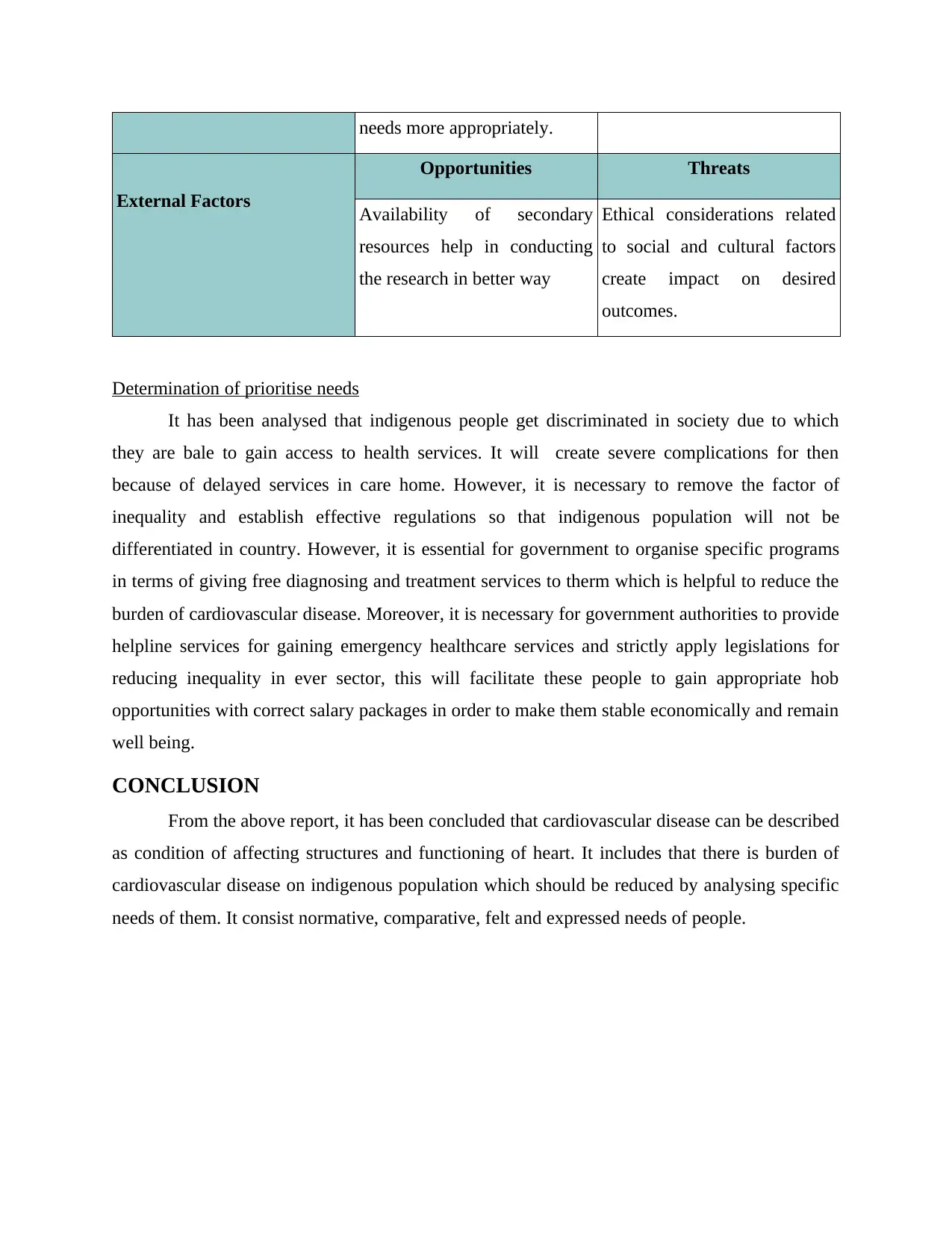
needs more appropriately.
External Factors
Opportunities Threats
Availability of secondary
resources help in conducting
the research in better way
Ethical considerations related
to social and cultural factors
create impact on desired
outcomes.
Determination of prioritise needs
It has been analysed that indigenous people get discriminated in society due to which
they are bale to gain access to health services. It will create severe complications for then
because of delayed services in care home. However, it is necessary to remove the factor of
inequality and establish effective regulations so that indigenous population will not be
differentiated in country. However, it is essential for government to organise specific programs
in terms of giving free diagnosing and treatment services to therm which is helpful to reduce the
burden of cardiovascular disease. Moreover, it is necessary for government authorities to provide
helpline services for gaining emergency healthcare services and strictly apply legislations for
reducing inequality in ever sector, this will facilitate these people to gain appropriate hob
opportunities with correct salary packages in order to make them stable economically and remain
well being.
CONCLUSION
From the above report, it has been concluded that cardiovascular disease can be described
as condition of affecting structures and functioning of heart. It includes that there is burden of
cardiovascular disease on indigenous population which should be reduced by analysing specific
needs of them. It consist normative, comparative, felt and expressed needs of people.
External Factors
Opportunities Threats
Availability of secondary
resources help in conducting
the research in better way
Ethical considerations related
to social and cultural factors
create impact on desired
outcomes.
Determination of prioritise needs
It has been analysed that indigenous people get discriminated in society due to which
they are bale to gain access to health services. It will create severe complications for then
because of delayed services in care home. However, it is necessary to remove the factor of
inequality and establish effective regulations so that indigenous population will not be
differentiated in country. However, it is essential for government to organise specific programs
in terms of giving free diagnosing and treatment services to therm which is helpful to reduce the
burden of cardiovascular disease. Moreover, it is necessary for government authorities to provide
helpline services for gaining emergency healthcare services and strictly apply legislations for
reducing inequality in ever sector, this will facilitate these people to gain appropriate hob
opportunities with correct salary packages in order to make them stable economically and remain
well being.
CONCLUSION
From the above report, it has been concluded that cardiovascular disease can be described
as condition of affecting structures and functioning of heart. It includes that there is burden of
cardiovascular disease on indigenous population which should be reduced by analysing specific
needs of them. It consist normative, comparative, felt and expressed needs of people.
Paraphrase This Document
Need a fresh take? Get an instant paraphrase of this document with our AI Paraphraser
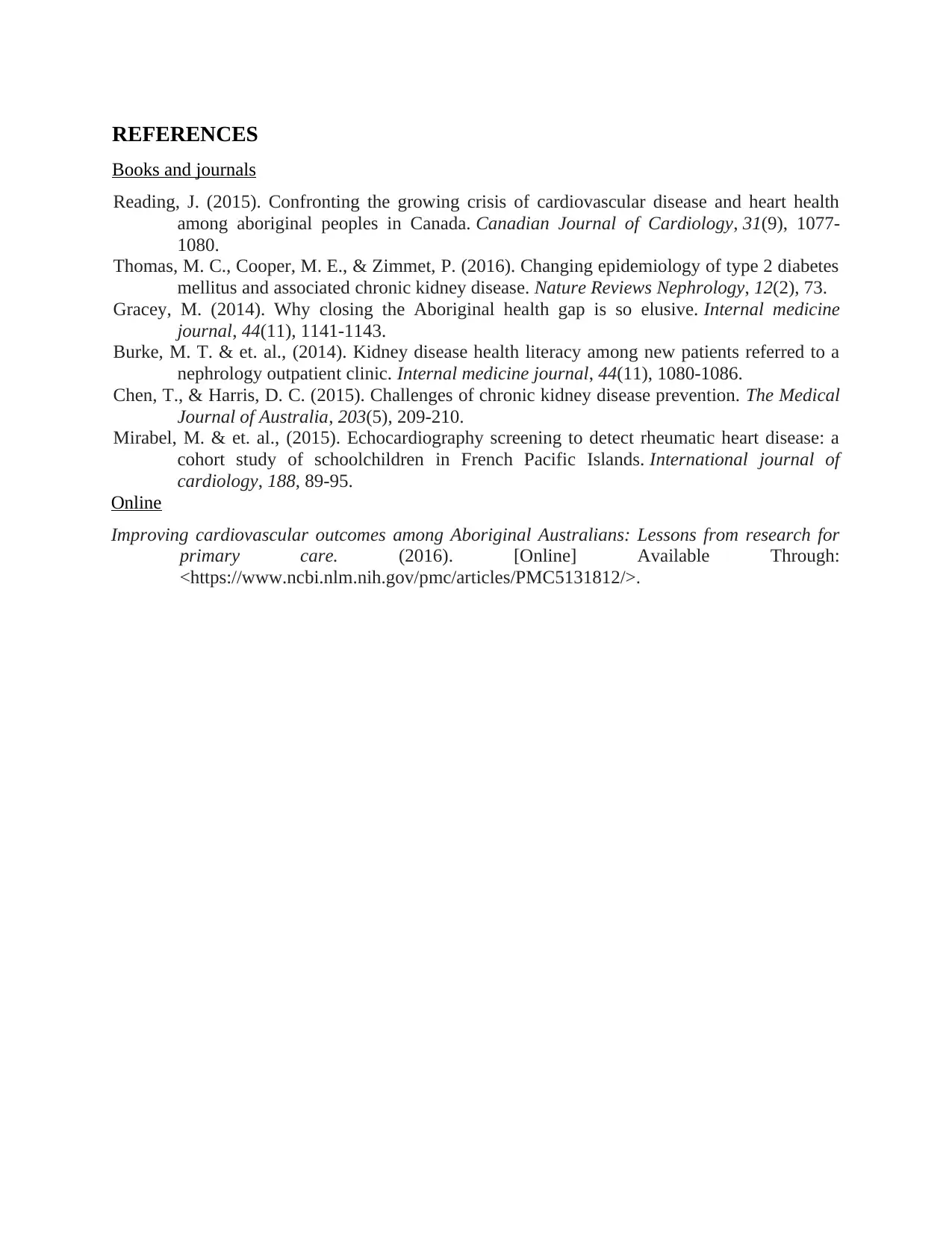
REFERENCES
Books and journals
Reading, J. (2015). Confronting the growing crisis of cardiovascular disease and heart health
among aboriginal peoples in Canada. Canadian Journal of Cardiology, 31(9), 1077-
1080.
Thomas, M. C., Cooper, M. E., & Zimmet, P. (2016). Changing epidemiology of type 2 diabetes
mellitus and associated chronic kidney disease. Nature Reviews Nephrology, 12(2), 73.
Gracey, M. (2014). Why closing the Aboriginal health gap is so elusive. Internal medicine
journal, 44(11), 1141-1143.
Burke, M. T. & et. al., (2014). Kidney disease health literacy among new patients referred to a
nephrology outpatient clinic. Internal medicine journal, 44(11), 1080-1086.
Chen, T., & Harris, D. C. (2015). Challenges of chronic kidney disease prevention. The Medical
Journal of Australia, 203(5), 209-210.
Mirabel, M. & et. al., (2015). Echocardiography screening to detect rheumatic heart disease: a
cohort study of schoolchildren in French Pacific Islands. International journal of
cardiology, 188, 89-95.
Online
Improving cardiovascular outcomes among Aboriginal Australians: Lessons from research for
primary care. (2016). [Online] Available Through:
<https://www.ncbi.nlm.nih.gov/pmc/articles/PMC5131812/>.
Books and journals
Reading, J. (2015). Confronting the growing crisis of cardiovascular disease and heart health
among aboriginal peoples in Canada. Canadian Journal of Cardiology, 31(9), 1077-
1080.
Thomas, M. C., Cooper, M. E., & Zimmet, P. (2016). Changing epidemiology of type 2 diabetes
mellitus and associated chronic kidney disease. Nature Reviews Nephrology, 12(2), 73.
Gracey, M. (2014). Why closing the Aboriginal health gap is so elusive. Internal medicine
journal, 44(11), 1141-1143.
Burke, M. T. & et. al., (2014). Kidney disease health literacy among new patients referred to a
nephrology outpatient clinic. Internal medicine journal, 44(11), 1080-1086.
Chen, T., & Harris, D. C. (2015). Challenges of chronic kidney disease prevention. The Medical
Journal of Australia, 203(5), 209-210.
Mirabel, M. & et. al., (2015). Echocardiography screening to detect rheumatic heart disease: a
cohort study of schoolchildren in French Pacific Islands. International journal of
cardiology, 188, 89-95.
Online
Improving cardiovascular outcomes among Aboriginal Australians: Lessons from research for
primary care. (2016). [Online] Available Through:
<https://www.ncbi.nlm.nih.gov/pmc/articles/PMC5131812/>.
1 out of 8
Related Documents
Your All-in-One AI-Powered Toolkit for Academic Success.
+13062052269
info@desklib.com
Available 24*7 on WhatsApp / Email
![[object Object]](/_next/static/media/star-bottom.7253800d.svg)
Unlock your academic potential
© 2024 | Zucol Services PVT LTD | All rights reserved.





